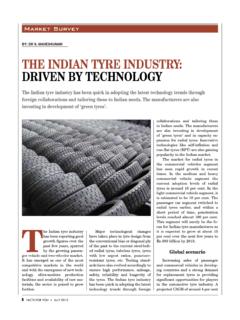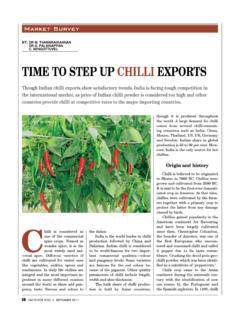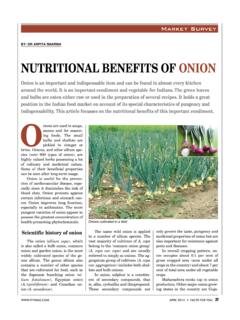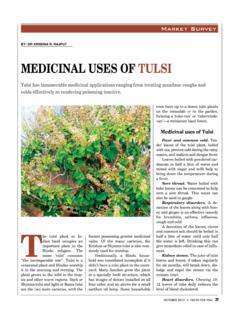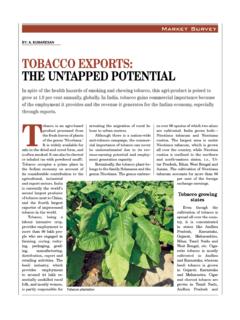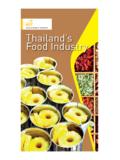Transcription of COCONUT INDUSTRY IN A NUTSHELL - …
1 Market SurveyCMYKBY: DR S. SUDALAIMUTHU,P. SENTHILKUMAR AND B. SIVAKUMARCOCONUT INDUSTRYIN A NUTSHELLC oconut is a popular plantation and is grown in more than90 countries of the world. India, producing 13 billion nutsper annum, is one of the market leaders in is a versatileproduct and has mul-tiple uses. Almost allthe parts of a freshlygrown COCONUT , eatableor otherwise, are used in some or theother manner. India is one of theleading COCONUT producers in theworld, producing 13 billion nuts perannum. COCONUT is mostly cultivatedin the coastal regions of the states that have abundant coco-nut growth are Andhra Pradesh,Assam, Goa, Karnataka, Kerala,Maharashtra, Orissa, Tamil Nadu,Tripura, West Bengal, Andaman andNicobar Islands, Lakshadweep varietiesCoconut fruit is categorised intotwo basic varieties according to thetype of palm tree bearing the Tall variety The tall varietyof COCONUT is slow growing.
2 The treeproduces fruits six to 10 years afterplantation, which is comparativelylate as compared to the other vari-ety. The tree remains productiveeven at the age of 80 to 120 yearsand produces good quality copra, oiland other products. The fruits of thepalm mature in 12 Dwarf variety The fruitsfrom the dwarf or short variety ofpalm tree are fast growing, thetree starts producing fruits in fourto five years time. The dwarf varietyof COCONUT palm has a relatively shortproductive age. The fruit may be ofvariable colours such as yellow, red,green and producersCoconut is a popular plantationand is grown in more than 90 coun-tries worldwide.
3 Though it is quitedifficult to establish a COCONUT plan-tation but once it is done, it provesto be quite beneficial as COCONUT isharvested throughout the year. Theworld production of COCONUT sumsup to around 55 million tonnes an-nually. Indonesia and Philippines arethe major producers of COCONUT fruitsin the world. The leading producersof COCONUT in 2005 along with pro-duction figures are listed below:1. Indonesia (1,63,000,00 metrictonnes)2. Philippines (1,45,000,00 met-ric tonnes)3. India (95,000,00 metric tonnes)4. Brazil (30,338,30 metrictonnes)5. Sri Lanka (19,500,00 metrictonnes)6.
4 Thailand (15,000,00 metrictonnes)7. Mexico (9,59,000 metrictonnes)8. Vietnam (9,400,00 metrictonnes)9. Malaysia (7,10,000 metrictonnes)10. Papua New Guinea (6,50,000metric tonnes)The top two countries in the listare serious competitors for the firstposition. But in the last few years,production in Philippines has beendeclining gradually. The area underMarket SurveyCMYK COCONUT cultivation in the world isaround 26 million acres. The overallproduction rate is looking up sincethe last decade with the rise beingaround 25 per cent. The productionlevel in the context of COCONUT oilhovers around million tonnes peryear and in the context of COCONUT oilcake, it is around two million scenarioCoconut has an important placein the Indian culture and has beenproduced here since time immemo-rial.
5 Currently, India holds the thirdplace in the list of major coconutproducing countries of the production in India was95,00,000 metric tonnes 12, nuts in 2005. The area underthe plantation cultivation is million hectares in the states that are important pro-ducers of this fruit and their annualaverage production figures are as fol-lows:1. Kerala (5727 million nuts)2. Tamil Nadu ( millionnuts)3. Karnataka ( millionnuts)4. Andhra Pradesh ( mil-lion nuts)5. West Bengal ( millionnuts)6. Orissa ( million nuts)7. Maharashtra ( millionnuts)8.
6 Assam ( million nuts)Kerala, the largest producer ofcoconuts in India, accounts foraround 45 per cent of the country stotal production. COCONUT oil is ob-tained from the copra of the fruitwith 65 to 70 per cent recovery the area covered undercoconut production, Kerala againstands first among the other majorcoconut producing states. The fol-lowing Table I gives a picture of co-conut production in India from 1991to I depicts the trend value ofgrowth in COCONUT production in In-dia. The trend value for the years1991, 1992, 1993, 1994, 2000, 2001,2003, 2004 and 2005 is more thanthe actual value of growth of produc-tion.
7 While the trend value for peri-ods 1995, 1996, 1997, 1998, 1999,and 2002 shows satisfactory future projections based onthe estimated growth in COCONUT pro-duction, is projected at 13, ,13, , 13, , 14, mil-lion of coconuts for the years 2007,2008, 2009 and 2010 of coconutproductsA variety of COCONUT products aremanufactured in the country whichhave both domestic and export mar-ket. Vinegar and soft drinks aremanufactured from COCONUT COCONUT water concentrate isanother product which is manufac-tured and marketed successfully. Theknow-how for preservation andpackaging of tender COCONUT waterhas been transferred to six firms inthe country.
8 Nata-de-coco is a gelati-nous delicacy formed by the actionof a micro-organism AcetobactorXylinium in a culture medium of co-conut water. The know-how for itsmanufacture is available with theBoard. Some of the main coconutproducts are: COCONUT products1. Tender COCONUT water2. Copra3. COCONUT oil4. Raw kernel5. COCONUT cakeCoconut export from Indiaincludes COCONUT (fresh and dried), COCONUT Production in India(Rs million)Table ICoconut Productionin India(Rs million)YearProductionTrend value19919, , , , , , , , , , , , , , , , , , , , , , , , , , , , , , , , , , , , SurveyCMYK copra, palm kernel/babassu oil,W/N refined not chemically modi-fied, COCONUT desiccated, crude oiland fractions, oil-cake and oil-cake meal expeller variety ofcoconut or copra, COCONUT coir(raw), hookah of COCONUT shell,flower carvings of coir, etc.
9 TableII gives the figures for COCONUT prod-uct exports in India for the period2001 to Table II, COCONUT productsexports and trend value estimatesfrom 2001 to 2010 are trend value for the years, 2001,2003, 2004 and 2007 are more thanthe actual value of growth of ex-ports, while the trend value of co-conut products exports in India isless than the trend value in theperiod 2005 to 2006. The table givesa not so satisfactory overall trendpicture as far as COCONUT productsexports are on the preceding trends, COCONUT products export value is es-timated at Rs 59, lakh, Rs64, lakh and Rs 69, in 2008, 2009 and 2010 DevelopmentBoardThe COCONUT Development Board(CDB) is a statutory body establishedunder the Ministry of Agriculture,government of India for the inte-grated development of COCONUT culti-vation and INDUSTRY in the country,with focus on increasing productiv-ity and product diversification.
10 Thefollowing schemes have beenlaunched by the board for this of CoconutDevelopment Board1. Production and distribution ofplanting material2. Expansion of area under coco-nut3. Integrated farming for produc-tivity improvement4. Technology demonstration5. Market promotion & statistics6. Information and informationtechnology7. Human re-sources develop-mentCoconutmarket inIndiaSince time im-memorial, coconuthas been associ-ated with the In-dian culture. Thesouthern part ofthe country liter-ally thrives on co-conut, it being astaple food there. It also forms partof the Indian religion and ethos andhas primary importance in numer-ous rituals and customs.
